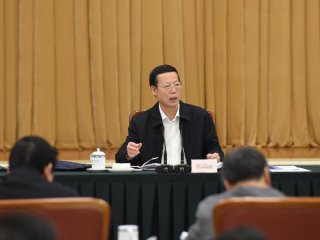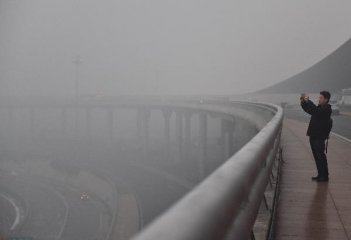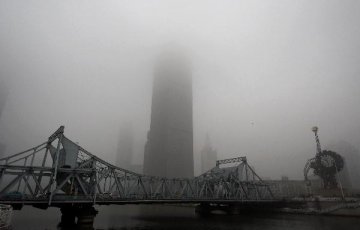
Beijing has issued its first red alert for air pollution under a four-tier emergency response system created in October 2013.
The red alert, the most serious level, will last from 7 a.m. on Tuesday to noon on Thursday. The city issued an orange alert, the second-highest level, on Saturday. Smartphone air quality apps, popular among Beijingers, showed an Air Quality Index (AQI) reading of more than 200 for almost all monitoring stations across the city on Monday, advising people to reduce outdoor activities.
It comes after the worst period of air pollution this year took AQI readings in the capital to the maximum 500 on Nov. 30. While the city did not issue a red alert during that spell of smog, the rules drawn up two years ago state that a red alert should be issued in periods when the AQI is expected to surpass 200 for three consecutive days.
Under a red alert, the city's emergency management headquarters has advised kindergartens, primary and high schools to suspend classes, banned outdoor operations on construction sites and required some industrial plants to limit or stop production.
Few students showed up to Beijing No.2 Experimental Primary School on Monday as the school sent out text messages giving them the choice of either staying home or coming to school.
He Jinglong, a physical education teacher of the affiliated school of Beijing Jiaotong University, led students in indoor exercise on Monday. "We designed a set of exercises specially for smoggy weather to keep students fit," said He.
The Beijing Education Commission issued a notice on Monday night asking all middle, primary schools and kindergartens to suspend classes during the red alert period. Car use will be limited during the red alert period as cars are allowed on the roads on alternating days depending on the odd or even numbers of their license plates.
In addition, 30 percent of government cars will be banned from streets on an odd/even basis. The restriction of car use is expected to push an extra two million passengers onto public transport per day. Beijing will add 21,000 to 25,000 buses, including 8,182 clean-energy buses, to the roads from Tuesday.
According to the Beijing Municipal Environmental Monitoring Center, heavy smog will linger until Thursday. It is expected to disperse on Thursday afternoon as a cold front arrives.
COMMON ACTION OF BEIJING, NEIGHBORS
Beijing is often shrouded in smog, triggering huge public concern. A considerable portion of pollutants in the city come from neighboring regions, particularly industrial Hebei Province, home to seven of the country's 10 most polluted cities.
Like Beijing, many cities in the neighboring provinces of Hebei and Shandong as well as Tianjin Municipality have taken emergency measures. Baoding, a city 150 kilometers from Beijing, will also implement an odd/even restriction on car use from Tuesday.
The local government already ordered more than 2,000 enterprises to suspend or reduce their operations and 1,200 construction sites to suspend operation for the whole of December. In the coastal Tianjin Municipality, earthwork at construction sites and vehicles transporting construction materials have been prohibited.
To try to ensure the effectiveness of anti-pollution measures, the environmental protection authorities of Beijing, Hebei and Tianjin are collaborating on a joint law enforcement action for the first time.
Industries including power supply, steel, metal, coke and concrete manufacturing are the focus of joint inspections, said Zhong Chonglei, head of the Beijing Environmental Inspection Squadron.
In Neiqiu County, Hebei Province, inspectors have been dispatched to major polluters. Viewing one chemical plant, inspector Zhang Yongge said all three of its sets of desulfurizing equipment have been running at full capacity since the orange alert was issued.
Li Guanglei, a senior official with the county's environment protection bureau, pledged that it would take all necessary measures to reach the target of reducing emissions by at least 30 percent.
The Tianjin municipal government dispatched 16 teams to inspect construction sites, ports and factories for air pollution.
According to a national action plan issued in September 2013, the Beijing-Tianjin-Hebei region should cut PM2.5, a key indicator of air pollution, by 25 percent from 2012 levels by 2017.






















Latest comments